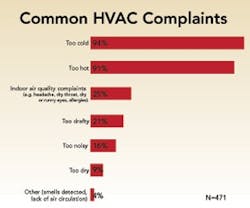The most common thermal complaint lodged by building occupants is that their spaces are too cold; frustratingly, the second most common is that they’re too hot, according to a 2009 IFMA study. This is a red flag that the temperature is uneven in your building.
With a few wireless devices and a little installation time, you can attack those complaints on three fronts: direct temperature control, humidity, and solar heat gain.
Temperature Sensing
For obvious reasons, gaining the best possible control over the temperature in a space is your best defense against discomfort. In an existing building, it’s not always feasible to open up the walls and run wires for thermostats.
Wireless temperature sensors not only monitor the temperature, they can also alert you if the temperature is outside a certain range. Some products offer a dashboard that communicates information such as battery life, saving you the trouble of waiting until sensors stop communicating. Comfort Dynamics, a full-service mechanical contracting firm, installed a $200,000 wireless control system as part of a radiant heating retrofit at Archbishop Riordan High School, a 91,000-square-foot boarding school in San Francisco.
“It was a roughly 60-year-old poured in place concrete structure, so running wires was very problematic,” says Tony DeMeo, Comfort Dynamics president. “There wasn’t a way to do that without a lot of destructive work in the process, not to mention expense.”
To combat wide temperature swings, which were due to the thermal lag of radiant heating in large areas of concrete flooring, the team installed temperature sensors, repeaters, and BACnet bridges, which integrated the classroom zone temperatures into a DDC control system.
This setup logs the average zone, outside air, and ambient solar temperatures and predicts the heating load and the temperature of coming days, compensating for upcoming temperatures so that no zone overshoots its set point.
Humidity Control
Your building may benefit from sensors that can track humidity on top of temperature and other issues, such as pressure, light, or egress. Paired with HVAC controls, this component can ensure workspaces operate at maximum comfort and efficiency.
“Humidity control is not as straightforward as temperature control because humidity varies with temperature,” says Kyle Baca, systems engineer for Compliance Control, which manufactures wireless monitoring systems. “To clear moisture from the air, you need to deploy equipment that can clear the humidity out, such as running the AC coil simultaneously with the heat coil so the space doesn’t get too cold, but you’re still condensing the moisture particles from the air. Determine where you have a problem and then address it.”
Industries like healthcare may require humidity monitoring, while in other spaces it’s simply a matter of keeping people comfortable. Monitoring can also combat changes brought on by seasons and variations in crowd density.
“When you have buildings that have large numbers of guests for banquets or conferences, you see a lot of changes in humidity and temperature,” Baca says. “When you have 50 to 60 people in a 400-square-foot room, that can impact the environment quite dramatically.”
Smart Shades
With daylighting comes two downsides – solar heat gain and glare. Bright sun streaming through the glass creates the perception of heat to people sitting in it, regardless of whether the temperature is higher.
A wireless shading system allows occupants to keep their view of the outside world, but the solar-reflective fabric in the shades will reduce heat gain and glare, which in turn cuts down on occupants adjusting or complaining about the temperature. Using wireless technology to address these tasks presents an extra advantage – it’s easier to reconfigure as needed.
“Wireless shade systems give a very granular level of control that most property managers like,” says Brennen Matthews, North American Specifications Manager for Lutron.
Some shading systems can adjust themselves based on geographical location, season, and other factors and can be linked to building automation or lighting control systems.
Janelle Penny ([email protected]) is associate editor of BUILDINGS.
About the Author
Janelle Penny
Editor-in-Chief at BUILDINGS
Janelle Penny has been with BUILDINGS since 2010. She is a two-time FOLIO: Eddie award winner who aims to deliver practical, actionable content for building owners and facilities professionals.

